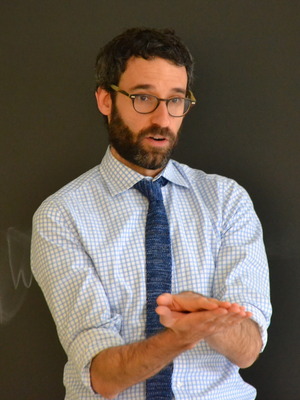Thomas S. Davis
Contributing Scholar and Co-Director 2017-2019
Department of English
Tommy helped conceptualize Livable Futures during the Collaboration for Humane Technologies events in 2017 and is an ongoing collaborator on several projects.
Biography
I began my academic career as a scholar of midcentury modernism. I was initially fascinated by the dialectical relay between the aesthetics of everyday life in late modernism and the large-scale shifts happening in the world system between the 1930s-1970s. That research resulted in my first book, The Extinct Scene: Late Modernism and Everyday Life (Columbia UP, 2016) and a batch of essays in Twentieth Century Literature, Textual Practice, Literature Compass, and several edited volumes. I became increasingly interested in the aesthetics and politics of energy as I finished that book. Those interests have pushed my current research fully into the emerging fields of Environmental and Energy Humanities. I am working on two monographs. Fossils of Tomorrow: Literature, Culture, and the Great Accelerationasks how midcentury cultural production mediated the contradictions of postwar growth and the emerging consciousness of planetary limits. I take up a broad, multimedia (and still growing) archive: innovative and unorthodox documentary films and travel guides funded by Shell-Mex; the early science fiction of J.G. Ballard and Ursula K. Le Guin; novels from the decolonizing Global South; environmental activist writing from the 1960s; the crossings of poetics and land art; and efforts by the Situationists to re-enchant and decommodify urban life. The first essay from this project will appear in December 2018 in Modern Fiction Studies in a special issue called “The Anthropocene: Fiction and the End(s) of Human Ecologies.” My other project, The Cultural Lives of Climate Change, asks how environmental attachments are made, unmade, and remade. At the moment, I am attempting to think through the politics and aesthetics of attachment via contemporary visual art by Brandon Ballengée and Cannupa Hanska Luger, poetry of Juliana Spahr and Layli Long Soldier, climate fiction from Octavia Butler, Jenni Fagan, and Berit Ellingsen, extreme music from bands like Panopticon, Twilight Fauna, and Nechochwen, and feral culture experiments. I have given invited talks drawn from this book in the last few years at the University of Notre Dame, Ohio University, Colorado State, and, most recently, at the Petrocultures Conference in Glasgow, Scotland. “Anthropocene Insecurities: Extraction, Aesthetics, and the Bakken Oilfields” appeared in English Language Notes 54.2 (Fall/Winter 2016). Another essay on committed art in the era of climate change will appear in a special issue of Polygraph on “Marxism and Climate Change” in 2019.
Q & A
What makes more livable futures for you?
I’m writing this as Hurricane Florence bears down on my home state where my family still lives; thinking about a livable future seems increasingly difficult (but increasingly urgent) as climate related disasters continue to unfold in front of us. I do, however, find glimpses of more just and livable futures in the growing climate justice movement, the degrowth movement, indigenous led actions against extraction, and the incredibly rich and ever-growing field of cultural production emerging from these struggles. I’m convinced that confronting climate change means system change, i.e., transitioning away from both fossil fuels and the paradigm of capitalist growth. Indigenous artists and writers like Cannupa Hanska Luger, Layli Long Soldier, and Leanne Betasamosake Simpson, degrowth writers Giorgo Kallis and Joan Martinez-Alier, and Naomi Klein and Rebecca Solnit have helped me think more carefully about the need to recast our ideas of abundance, collectivity, multi-species living, and mutual aid in the Anthropocene.
What are you reading, viewing, listening to right now?
I’m reading a lot of climate fiction that does more than just reproduce and dwell in disaster scenarios. In that vein, I’ve recently finished N.K. Jemisin’s The Fifth Seasonand Jeff VanderMeer’s Borne; I’m currently working through Claire Vaye Watkins’ Gold Fame Citrus. I’ve also been toggling back and forth between Marxist ecologies and new materialism. Andreas Malm’s The Progress of This Stormand Stacey Alaimo’s Exposed have been my most recent reads in contemporary theory. I just ordered Wendy Trevino’s new book Cruel Fiction and I can’t wait to read it. I listen to a lot of black metal, drone, and ambient music that takes up environmental issues in form and content. Recently that’s meant Appalachian black metal by Twilight Fauna, Nechochwen, and Panopticon and ambient artist Krzyzis’ new record “Degrowth.” I also listen to a lot of punk, dungeon synth, noise, and black and death metal that has nothing to do with my research. Muncie Girls “Fixed Ideals,” Sainte Marie des Loupe’s self-titled LP, Fiddlehead “Springtime and Blind,” Closet Witch’s self-titled LP, Wayfarer “World’s Blood,” and Svalbard’s aptly titled “It’s Hard to Have Hope” have all been on heavy rotation.
What practices are sustaining you?
I started political organizing with the Democratic Socialists of America in the last few months and that’s been generative. My family built a micro-habitat for butterflies, milkweed beetles, and other creatures this summer. We also spent time away at the Carolina coast and in Hocking Hills over the summer. I’ve also done a fair amount of traveling to wild places in Argentina, Antarctica, and Scotland in the last year; those landscapes and the vibrant and fragile ecologies in them were remarkable to see. And teaching! I’m constantly enlivened and surprised by the political passions and creative energies of our students.
